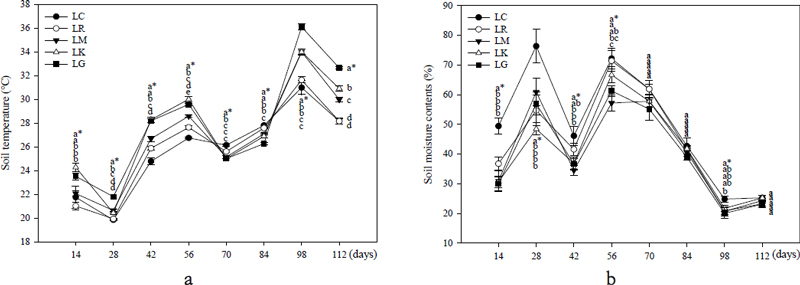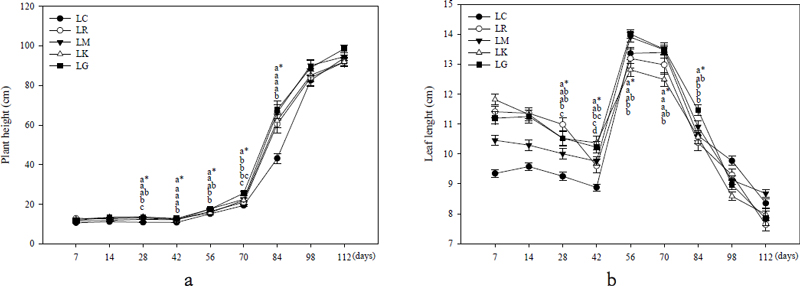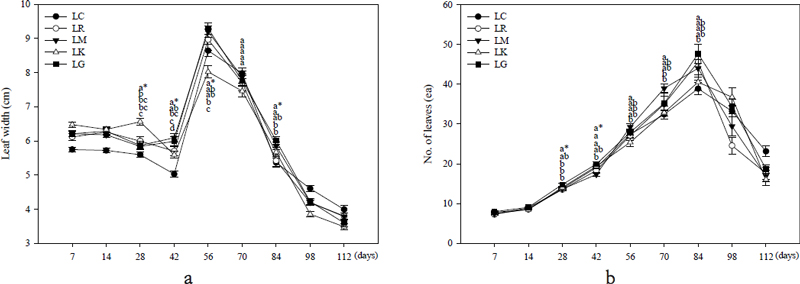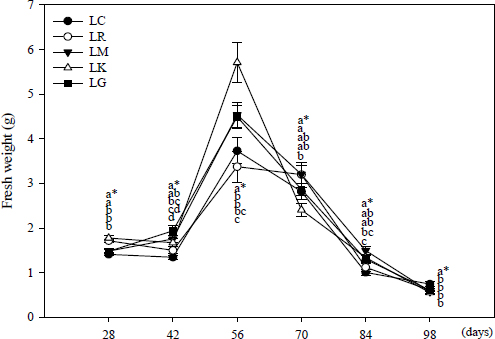
옥상 도시농업에서 방향식물과의 공영식재에 따른 상추의 생육 및 해충방제 효과
Ⓒ The Korean Environmental Sciences Society. All rights reserved.
This is an Open-Access article distributed under the terms of the Creative Commons Attribution Non-Commercial License (http://creativecommons.org/licenses/by-nc/3.0) which permits unrestricted non-commercial use, distribution, and reproduction in any medium, provided the original work is properly cited.
Abstract
The objective of this study were to assess rooftop urban agriculture and analyze the differences in soil, growth, physiology, and productivity to elucidate the effect of companion planting with various plants, including lettuce (Lactuca sativa), rosemary (Salvia rosmarinus), marigold (Tagetes patula), Korean perilla (Perilla frutescens), and garlic chives (Allium senescens). Measurements were taken every other week from May to August 2023, totaling eight measurement. Regarding the characteristics of the soil planted with lettuce and aromatic plants, the combined planting of lettuce and garlic chives created a favorable soil environment for plant growth. Consequently, the best growth was observed when lettuce and garlic chives were companion planted. Companion planting of lettuce and garlic chives appears to be the most efficient concerning growth and physiology. The productivity of companion planting lettuce and aromatic plants also showed high-quality lettuce when lettuces and garlic chives were companion planted. Therefore, companion planting of lettuces and garlic chives in rooftop urban agriculture is suitable for growth, physiology, and productivity.
Keywords:
Rooftop urban agriculture, Companion planting, Lettuces, Rosemary, Marigold, Perilla, Garlic chives1. 서 론
도시의 인구 밀집은 토지 가격을 상승시키고, 이로 인해 녹지공간이 부족해져 환경이 악화된다. 또한, 농어촌에서 생산된 식재료의 운송은 식량안보와 지속가능한 식품생산 등이 중요한 과제로 인식되고 있다. 녹지 공간을 늘리기 위해서 일반적으로 주택의 뒤뜰이나 마당, 발코니, 옥상 등 소규모 텃밭의 형태와 도심 속 공터, 공원, 도로 주변 및 도시 근교에 정원 등을 조성되어야 하며, 도시 주민들의 취미 및 여가생활, 노인 일자리 창출, 학생들의 학습과 체험 목적의 농업교육을 위해서 도시농업 활동이 진행되어야 한다(Lee et al., 2013). 도시에서 거주하는 도시민들은 안정적이고 안전한 식품 공급에 대한 우려를 가지게 되었고, 이에 따라 도시에서의 식품생산을 촉진하고 도시민들에게 안전한 식품을 제공하기 위한 대안으로 도시농업이 주목받고 있다. 또한 현대 시민들은 환경적 삶의 질 향상을 목표로 녹지공간을 확대하고 자급자족 형태의 취미활동으로 도시농업을 실행하고 있다(Han, 2014). 농업에서 병해충 방제를 위해 관행농업에서는 농액과 비료를 무분별하게 사용해왔다. 이러한 방식은 환경에 부정적 영향을 끼친다. 작물을 키워서 생산성을 늘리는 농업에 농약과 비료를 사용하는데 환경친화적이며 건강한 삶의 질적 성장을 요구하는 도시민들의 수요가 증가하는 요즘, 건강한 먹거리에 대한 관심이 증가하고 있다(Chae et al., 2020). 인구가 밀집된 도심이라는 장소의 특성을 고려할 때 농약과 화학비료는 건강, 환경적으로 문제를 야기할 수 있으며, 지속가능한 농업의 측면에서 많은 문제를 발생시키기에 지양해야 하는 문제이다. 농약과 비료에 민감하기 때문에 친환경 농업의 필요성이 대두된다. 친환경 농업이란 생산과정에서 물, 공기, 토양의 오염을 최소화하기 위해 화학 농약, 비료, 항생제를 사용하지 않거나, 최소한으로 투입하여 농업 생산력과 생태계를 유지, 보존하면서 안전한 농산물을 생산하는 농업 형태를 말하는데, 공영식물을 이용한 작물 재배가 그 대안으로 주목받고있다. 공영식재(companion planting)는 두 종 이상의 식물을 식재하여 작물들의 특성의 영향을 받아 서로 이익을 얻을 수 있도록 하는 식재 방법이다(Dejong, 2017). 하지만 공영식재는 우리나라에서 생소한 기법이며 이를 상용화하기 위해서 국내에서도 다양한 수종을 이용한 연구들이 진행되었으나(Kim et al., 2013), 실험에 적용한 식물의 수종이 한정적이고 관련된 작물과 허브의 조합에 관한 연구가 미비한 실정이다.
Im et al.(2009)은 도시농업을 도시 내에서 이루어지는 농업으로, 녹지공간 증가뿐만 아니라 교육, 환경, 복지 등의 향상을 목적으로 하여 공동체 구성원의 자율적 참여를 통해 도시환경 개선을 위한 농업 활동으로 정의하였다. 도시농업은 식량 생산 외에도 지역에서 생산된 식품을 소비함으로써 식품 수송에 필요한 에너지를 절약하고, 이로 인해 발생하는 이산화탄소를 감소시키며 쓰레기 감소 효과를 가져다줄 수 있다(Son et al., 2013). 또한 도시농업은 도시의 녹지 공간을 늘리는 동시에 이산화탄소를 흡수하고 산소를 방출하여 도심 열섬을 완화할 수 있다. 도시농업은 도시 내에서 공간을 확보하고 참여를 증가시키며 가치를 증진시키는데 중점을 둔다. 특히 고층 건물의 옥상은 주말농장과 같은 생활권 내에서 쉽게 접근할 수 있는 장소로 활용되고 있으며, 일반적인 옥상 녹지지에 공원 조성, 작물 재배, 각 식물의 특성에 맞는 방법으로 농사를 진행하는 방식이 흔히 사용된다(Won, 2013). 이와 같이 안전한 먹거리 생산을 위한 자급자족 형태의 도시농업은 수요가 계속해서 증가하고 있다. Lee and Yang(2021)은 지속 가능한 도시 발전이 경제 및 사회구조뿐만 아니라 생태적 지속 가능성과의 균형과 조화가 중요하다고 제언하였다. 뿐만 아니라 도시의 균형 잡힌 발전을 위해서는 도시농업이 제공하는 환경적이고 사회공익적인 기능 뿐만 아니라 도시민들의 여가활동을 위한 기능과 가치를 확대시켜야 한다고 강조하였다. 또한 2010년부터 2019년까지 도시텃밭의 재배 면적은 12.7배 증가하였으며 참여자 수는 약 241만명으로 15배 증가하였다고 보고하였다. 이러한 옥상 도시농업의 발전을 위해 환경에 적합한 작물이 선발되었는데, 연구 결과에 따르면 옥상 환경에서 손쉽게 재배할 수 있는 과채류로는 상추, 토마토, 방울토마토, 가지, 애호박, 단호박, 참외 등 7종, 엽채류로는 상추, 쑥갓, 아욱, 겨자채, 로메인상추, 콜라비, 케일, 잎들깨, 부추 등이 정상적인 수확과 생육이 가능하다는 것이 확인되었다(Jeong et al., 2010). 옥상이라는 특수한 환경의 한계를 보완하기 위해 다양한 실험 방법이 적용되었고, 이러한 실험을 통해 식물이 효과적으로 생육하는 방법을 파악하는 연구가 진행되었다. Ha et al.(2011)는 식물 생육에 상대적으로 불리한 환경인 옥상에서 효과적으로 먹거리를 생산하기 위해 인공지반 내 토양 깊이와 식재밀도가 채소류의 생육에 미치는 영향을 조사했다. 연구 결과에 따르면, 인공지반 녹화 시 토양 깊이는 약 20 cm 정도가 적당하며, 식재밀도는 밀식재배가 가능하다고 보고하였다.
선행 연구들은 주로 옥상이라는 공간을 활용한 사회공익적 기능에 중점을 두어 공간적 특성의 선호도나 운영 현황을 조사하고, 옥상에 적합한 작물을 선정하여 생육 실험을 수행하는 방식으로 진행되었다. 그러나 옥상 도시농업을 실시할 때, 다양한 방향식물과의 공영식재를 통해 상추와 상추의 토양 환경, 생육, 그리고 생산성을 비교하여 옥상 도시농업을 효율적이고 안정적으로 수행할 수 있는 과학적 근거자료가 필요한 실정이다. 이에 본 연구는 생활권 내 접근성이 높은 건축물에서 옥상 도시농업에 적합한 상추(lettuce), 로즈마리(rosemary), 메리골드(marigold), 잎들깨(Korean perilla), 부추(garlic chives)를 선정하여 작물의 생육 및 생리, 생산성을 비교하고, 공영식재한 방향식물의 효과를 알아봄으로써 친환경 옥상 도시농업을 위한 기초자료로 제시하고자 한다.
2. 범위 및 방법
2.1. 연구재료
공시재료로 상추는 ‘적치마상추’(Lettuce, Famhannong Co, Korea)를 품종으로 사용하였고, 본엽이 5 – 6매가 발생한 유묘를 선정하였다. 본 연구에 사용된 토양 재료는 옥상녹화용 인공토양인 포시즌(Fourseason, Samhwa Greentech, Korea)과 펄라이트(Perlite, Homan Industry, Korea)로 인공토양과 펄라이트를 3대 1 비율로 포설하였다.
본 실험은 2023년 5월부터 9월까지 수행하였으며, 건국대학교 글로컬캠퍼스 복합실습동 옥상에서 실시하였다. 실험구는 가로, 세로, 높이 100 cm, 100 cm, 25cm의 정방형 모듈로 조성하였다. 상추는 잎이 주요 수확 부위이므로 넓은 공간에서 잘 자랄 수 있도록 식재간격을 25 cm로 정식하였다. 배수가 용이하도록 실험구하부에 배수판, 부직포를 깔고 펄라이트를 5 cm 포설하였으며, 그 위에 옥상녹화용 인공토양인 포시즌을 15cm 포설하였다. 공영식재에 따른 토양수분, 생육 및 생리, 생산성, 해충방제의 비교를 위해 5가지 식물로 3 반복하여 총 15개의 실험구를 조성하였다. LC (Lettuce Control)에는 상추를 12포기를 단일식재 하였고, LR(lettuce 2 : rosemary 1), LM (lettuce 2 : marigold1), LK (lettuce 2 : Korean perilla 1), LG (lettuce 2 : garlic chives 1)에는 상추 8포기를 4포기씩 식재하고 그 사이에 허브 4포기를 교열식재 하였다.
2.2. 연구방법
통계분석은 실험 테이터를 PASW Statistics 27(SPSS Inc, Chicago, IL, USA)프로그램을 사용하였다. 공영식재에 따른 실험구간의 유의성 검증을 위해 일원배치분산분석 사후검정으로 5% 수준에서 Duncan’s multiple range test를 수행하였고, SigmaPlot 12.3(Systat, SAN Jose CA, USA)을 통해 결과를 그래프로 나타내었다.
3. 결과 및 고찰
3.1. 토양 특성
상추의 토양 온도는 LG 32.64, LK 30.91, LM 29.97, LC 28.15, LR 28.15℃ 순으로 나타났다. 식재 기준 98일 후 LG 처리구에서 36.1℃ 로 가장 높은 온도를 확인할 수 있었다. 상추의 토양 수분함량으로 식재 후 28일 LC에서 76.3% 로 가장 높았으며 56일 이후 점차 줄어드는 경향을 보였다(Fig. 1). 실험 기간 토양의 온도와 수분함량은 기상 환경의 영향을 받은 것으로 사료된다.

Changes in soil temperature and moisture contents in each experimental plot according to companion planting of lettuce and herbs. Vertical bars represent standard error (SE) of the mean. a: soil temperature, b: soil moisture contents. LC: lettuce control, LR: lettuce+rosemary, LM: lettuce+marigold, LK: lettuce+Korean perilla, LG: lettuce+garlic chives. Different letters indicate significant differences at p < 0.05 using Duncan’s test. *: p < 0.01.
3.2. 상추의 생육 및 생리 특성
상추의 초장은 LG, LM, LC, LK, LR 순으로 길어졌고, 시간이 지날수록 추대가 되어 커지는 모습을 보였다. LG의 초장이 가장 높게 자란 것을 확인할 수 있지만 실험구 간 통계적으로 유의하지 않다고 분석되었다. 상추의 생산성으로 엽장은 LG 14, LM 13.9, LC 13.36, LR 13.19, LK 12.81 cm 로 식재 후 56일에 가장 길었다. 상추는 토양 수분함량이 충분한 조건에서 엽장과 엽폭이 커지며 엽수가 많아진다는 Rural Development Administration(2020)의 선행연구가 있는데 이처럼 토양 수분함량이 높았을 때 상추의 생산성이 좋은 것을 보여주었다(Fig. 2).

Changes in plant height and leaf length of lettuce in each experimental plot according to companion planting of lettuce and herbs. Vertical bars represent standard error (SE) of the mean. a: plant height, b: leaf length. LC: lettuce control, LR: lettuce+rosemary, LM: lettuce+marigold, LK: lettuce+Korean perilla, LG: lettuce+garlic chives. Different letters indicate significant differences at p < 0.05 using Duncan’s test. *: p < 0.01.
엽장과 마찬가지로 식재일 기준 56일 후에 LG 9.98, LM 9.29, LR 8.99, LC 8.02 cm 순서로 상추와 부추를 공영식재한 LG 처리구에서 가장 높은 값을 나타내었다. 엽수는 LC 23.14, LG 18.37, LR 17.62, LM 16.95, LK 16.54 개 순으로 처리구별 통계적인 차이가 유의한 것을 확인할 수 있었고, 엽수가 가장 많이 나타난 것은 식재 이후 84일에 LG에서 47.66 개를 확인할 수 있었다(Fig. 3).

Changes in leaf width and number of leaves of lettuce in each experimental plot according to companion planting of lettuce and herbs. Vertical bars represent standard error (SE) of the mean. a: leaf width, b: number of leaves. LC: lettuce control, LR: lettuce+rosemary, LM: lettuce+marigold, LK: lettuce+Korean perilla, LG: lettuce+garlic chives. Different letters indicate significant differences at p < 0.05 using Duncan’s test. *: p < 0.01.
3.3. 해충 섭식흔적
상추의 해충 섭식흔적으로 LM 11.21, LR 9.12, LK 8.54, LG 8.33, LC 7.08개 순으로 식재 이후 56일까지는 해충 섭식흔적이 자주 나타나지 않았지만 70일 이후로 눈에 띄게 보이기 시작했다(Fig. 4).

Changes in number of pest feeding traces of lettuce in each experimental plot according to companion planting of lettuce and herbs. Vertical bars represent standard error (SE) of the mean. Measurements were taken at two-week intervals after planting. LC: lettuce control, LR: lettuce+rosemary, LM: lettuce+marigold, LK: lettuce+Korean perilla, LG: lettuce+garlic chives. Different letters indicate significant differences at p < 0.05 using Duncan’s test. *: p < 0.01.
3.4. 상추의 생산성
수확이 가능한 상춧잎의 생체중은 LC 0.74, LG 0.6, LR 0.6, LM 0.57, LK 0.55 g 순으로 처리구별 통계적인 차이가 유의한 것을 확인할 수 있었다. 또한 식재 56일 후 LK 처리구에서 5.7 g 으로 가장 높은 수치를 보였다(Fig. 5).

Changes in leaf fresh weight of lettuce in each experimental plot according to companion planting of lettuce and herbs. Vertical bars represent standard error (SE) of the mean. Measurements were taken at two-week intervals after planting. LC: lettuce control, LR: lettuce+rosemary, LM: lettuce+marigold, LK: lettuce+Korean perilla, LG: lettuce+garlic chives. Different letters indicate significant differences at p < 0.05 using Duncan’s test. *: p < 0.01.
상추의 지상부 생체중은 LG 71.47, LM 66.41, LR 56.31, LC 54.2, LK 49.33 g 순으로 나타났고, 지하부의 생체중은 LM 35.09, LC 30.16, LR 27.46, LK 24.77, LR 21.08 g 으로 측정되었다. 지상부는 LG 처리구에서 지하부는 LM 처리구가 가장 높은 값을 보였다. 상추의 지상부 건물중은 LG 17.22, LM 14.5, LR 14.06, LK 12.72, LC 12.62 g 순으로 분석되었고 실험구 간에 유의한 차이를 나타냈다. 지하부는 LM 6.78, LK 6.58, LC 6.12, LR 5.91, LG 4.68 g 으로 분석되었으나 처리구별로 큰 차이를 나타내지 않았다(Fig. 6).

Changes in fresh weight and dry weight of lettuce in each experimental plot according to companion planting of lettuce and herbs. Vertical bars represent standard error (SE) of the mean. a: fresh weight, b: dry weight. LC: lettuce control, LR: lettuce+rosemary, LM: lettuce+marigold, LK: lettuce+Korean perilla, LG: lettuce+garlic chives. Different letters indicate significant differences at p < 0.05 using Duncan’s test. *: p < 0.01.
4. 결 론
본 연구는 상추와 공영식재한 방향식물이 토양, 상추의 생육 및 생산성, 해충방제에 미치는 영향을 평가하여, 옥상 도시농업에서 효율적인 재배환경을 위한 근거자료를 제공하기 위해 실험하였고, 결과는 다음과 같다.
토양온도와 수분함량은 모두 상추와 부추를 공영식재한 LG 처리구에서 가장 높은 수치를 보였다.
상추의 생육 및 생리 측정 결과 초장은 LG 98.54, LM 94.52, LC 93.92, LK 91.89, LR 91.84 cm 순으로 식재하고 시간이 지날수록 추대되어 커지는 모습을 보였다. 지상부 생체중은 LG 71.47, LM 66.41, LR 56.31, LC 54.2, LK 49.33 g 순으로 나타났고, 지하부의 생체중은 LM 35.09, LC 30.16, LR 27.46, LK 24.77, LR 21.08 g 으로 측정되었다. 지상부는 LG 처리구에서, 지하부는 LM 처리구가 가장 높은 값을 보였다. 지상부 건물중은 LG 17.22, LM 14.5, LR 14.06, LK 12.72, LC 12.62 g 순으로 분석되었다. 지하부는 처리구별로 큰 차이를 나타내지 않았다.
생산성 분석 결과 엽장은 LG 14, LM 13.9, LC 13.36, LR 13.19, LK 12.81 cm 으로 식재 후 56일에 가장 길었다. 엽폭은 엽장과 마찬가지로 식재일 기준 56일 후에 LG 9.29, LM 19.98, LR 8.99, LC 8.02cm 순서로 실험 기간 중 가장 큰 값을 나타내었다. 엽수는 LC 23.14, LG 18.37, LR 17.62, LM 16.95, LK 16.54 개 순으로 처리구별 통계적인 차이가 유의한 것을 확인할 수 있었고, 엽수가 가장 많이 나타난 것은 식재 이후 84일에 LG에서 47.66 개를 확인할 수 있었다. 상추잎의 생체중은 LC 0.74, LG 0.6, L2R1 0.6, LM 0.57, LK 0.55 g 순으로 처리구별 통계적인 차이가 유의한 것을 확인할 수 있었다. 또한 식재 56일 후 LK 처리구에서 5.7 g 으로 가장 크게 나타났다.
해충방제 효과에서 해충 섭식흔적은 LM, LR, LK, LG, LC 순으로 식재 이후 56일까지는 해충 섭식흔적이 자주 나타나지 않았지만 70일 이후로 눈에 띄게 보이기 시작했다.
이에 옥상 도시농업에서 상추와 부추를 공영식재하는 방법이 가장 효과적인 작물 재배를 방식으로 보여진다. 이는 부추가 상추의 성장에 긍정적인 영향을 미치기 때문이다. 하지만 옥상의 환경 특성상 이에 맞는 작물 관리 방안이 제시되어야 할 것이며, 추후 식재 비율을 세부적으로 나누어 성분분석을 하는 등 추가적인 연구가 필요할 것이라 본다.
Acknowledgments
이 성과는 정부(과학기술정보통신부)의 재원으로 한국연구재단의 지원을 받아 수행된 연구임(No. 2021R1F1A1063456)
REFERENCES
- Chae, Y., Lee, S. M., Jung, Y. B., Hong I. K., 2020, Development of functional planting model and manual for diversification of vegetable garden, Rural Development Administration, NTIS, 1395061181.
- Dejong, D., 2017, Companion planting: Effects of radishes on squash bugs, Environmental Studies Undergraduate Student Theses, Nebraska University, Lincoln, USA
- Ha, Y. M., Kim, D. Y., Gu, K. H., Hwang, D. K., Park, H. R., Yun, S. J., 2011, Rooftop vegetable garden for green roof system, J. Korean Env. Res. Tech., 14(1), 77-88.
- Han, J. H., Chang, D. M., 2014, A study on the sustainable development direction through theory, paradigm and typology of urban agriculture, J. Urban des. Inst. Korea, 15(6), 33-46.
- Im, H. S., Jo, W. B., Hong, G. P., 2009, Plan to revitalize urban agriculture to expand green space, Journal of the Korean Institute of Landscape Architecture, 128-130.
- Jeong, M. I., Kwang, J. K., Eun, H. Y., Sun, J. J., Seung, W. H., Dong, W. L., Jeong, S. S., 2010, Selection of leaf vegetables easy to grow in rooftop vegetable garden, Proceedings of the Korean Society for Horticultural Science Conferences, 38.
-
Kim, M. J., Shim, C. K., Kim, Y. K., Jee, H. J., Yun, J. C., Park, J. H., Han, E., Jung, H., Sung, J., 2013, Effect of inter-and mixed cropping with attractant and repellent plants on occurrence of major insect pests in organic cultivation of Chinese cabbage, Korean J. Org. Agric., 21(4), 685-699.
[https://doi.org/10.11625/KJOA.2013.21.4.685]

-
Lee, B., Yang, D. H., Lee, E. H., 2013. Analysis of urban agriculture policy and status. J. People Plants Environ., 16(3), 151-159.
[https://doi.org/10.11628/ksppe.2013.16.3.151]

-
Lee, S. Y., Yang, B. W., 2021, A Study on the criteria for measuring the value of gardening based on urban agriculture, J. East Asian Landscape Studies, 15(1), 43-53.
[https://doi.org/10.51549/JORAL.2021.15.1.043]

- Rural Development Administration, 2020, Agricultural technology guide 160 lettuce, 1-264.
- Son, M. S., Tong, J. S., Kim, H. S., 2013, Economic valuation methods to evaluate the progressive changes in values of urban farming, Journal of the Korean Regional Science Association, 29(1), 67-84.
- Won, S. Y., 2013, Farming types and plant resources proper to vegetable gardening of rooftop for urban agriculture activists, Korea Society Floral Art & Design, (28), 181-201.
Department of Green Technology Convergence, College of Science & Technology, Konkuk Universitytlsdlqtod2233@kku.ac.kr
Department of Green Technology Convergence, College of Science & Technology, Konkuk Universitydianau@kku.ac.kr
Department of Green Technology Convergence, College of Science & Technology, Konkuk Universityyonghan7204@kku.ac.kr
Department of Green Technology Convergence, College of Science & Technology, Konkuk Universityjjhkkc@kku.ac.kr